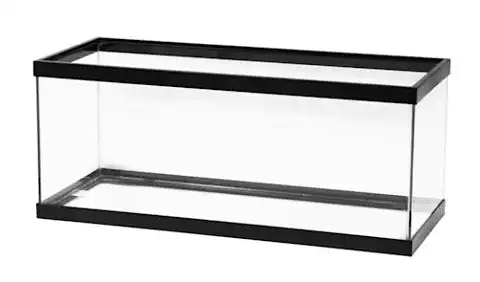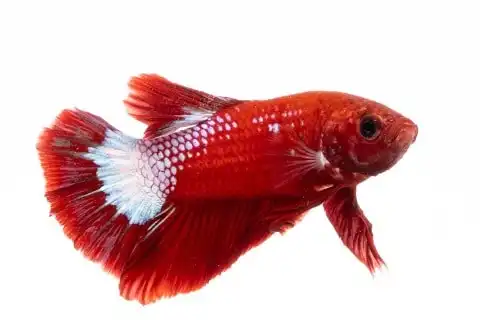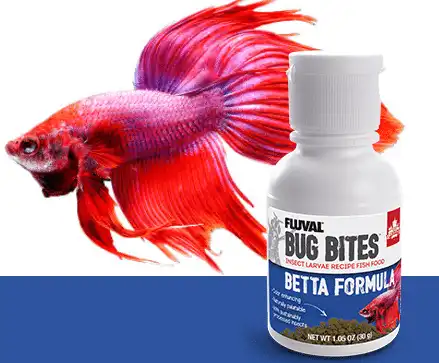Thank you for visiting! By the way… any links on this page that lead to products on Amazon and other stores/partners are affiliate links Aquarium Store Depot earns a commission if you make a purchase.
Freshwater angelfish and betta fish are two of the most popular aquarium fish species on the planet, so it’s no surprise that many fishkeepers want to keep them together. On their own, these stunning species have a lot to offer everyone from beginner pet owners to advanced aquarists, but can they be kept in the same tank?
Sometimes, housing bettas and angelfish together works out, but it depends on the tank, the fish’s personalities, and some other important factors. Realistically, you’re looking for trouble in the long run by housing these fish together, and there are much better tank mate options for both species.
In this post, we’ll explore the relationship between these two aquarium superstars, and explain why you probably don’t want to add these two fish to the same tank.
Key Takeaways
- Betta fish and angelfish are not recommended as tank mates.
- Some aquarists may have successfully housed these fish together in larger aquariums (55-gallon +) but it’s important to have a spare tank ready in case you notice any signs of aggression.
- Bettas can be aggressive, but they are slow swimmers and stay much smaller than angelfish, so they are more likely to be the victim in an aggressive encounter.
Can Angelfish And Bettas Live Together? – No!!!
Here’s your quick answer. In the vast majority of cases, Bettas cannot live with Angelfish in the same tank. Now that you know the answer, let’s go into why it doesn’t work.
Why It Doesn’t Work
Let’s take a look at some of the issues you’re likely to face.
Tank Size
On paper, angelfish and betta fish prefer similar water parameters, so you might think they make ideal tank mates. However, these fish have very different tank size requirements.
A classic 20 gallon aquarium in its 30 inch long variant. A very popular aquarium.
You’ll need at least 20 gallons to house young angelfish and a 55 gallon tank for adults, but just 5 gallons or more to house bettas. So, you definitely can’t add angelfish to a small betta fish tank.
Aggression
Both angelfish and bettas can be aggressive fish, depending on their personalities. Both fish also have long fins, so they can be vulnerable to fin nipping.
However, a full grown angelfish is much larger than a betta fish, so if there’s any aggression, the betta is going to come off second best.
Angelfish can become especially aggressive during breeding, so if you have males and females, there’s even more risk of them harming your betta fish.
Illness
Aggression can turn your community tank into a toxic environment that is as stressful for you as it is for your fish. Unfortunately, aggression also causes illness and even death in pet fish.
A bullied fish often sustains minor injuries that leave them vulnerable to secondary infections. In some cases, aggressive betta fish or angelfish will even kill their victims outright!
Betta Basics
Betta fish (also known as Siamese fighting fish) are small freshwater fish that usually reach about 2.5 inches in length. Today, they are prized for their amazing colors and fancy fins, but these fish were once bred for competitive fighting.
Use Coupon Code ASDFISH at Checkout
Betta Fish are one of the most beautiful varieties of freshwater fish available in the hobby. Easy to care for with plenty of varieties!
Bettas have a reputation for aggression, although they can make excellent community fish. A lot depends on their individual personality, but male bettas are likely to fight with their own species if housed in the same tank. It’s always safer to keep just one betta in its own aquarium, or with other compatible species.
Female bettas are generally regarded as less aggressive than males, although most fishkeepers choose males for their brighter colors and longer fins. You can learn much more about female bettas from my complete female betta care guide.
Betta fish live in shallow, freshwater habitats and have evolved to breathe air from the surface for survival1. Their hardy nature means they can be kept in tanks as small as 5 gallons, although they require a filter and regular tank maintenance to provide good water quality. Bettas are tropical fish so they also need heated water to stay active and healthy.
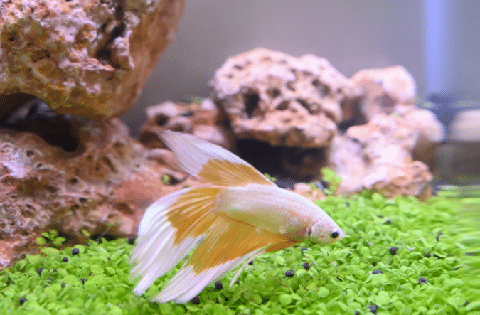
Check out my guide to 15 betta fish tank mates (and four to avoid) for advice on some great freshwater fish that can share a tank with a Siamese fighter!
Facts and Figures
- Scientific name: Betta splendens
- Fish family: Osphronemidae
- Origin: Southeast Asia
- Diet: Carnivore
- Temperature: Upper 70s to mid 80s Fahrenheit
- pH: 6.8 – 7.5
- Hardness: Soft
Angelfish in a Nutshell
Angelfish are medium-sized South American fish from the cichlid family. These popular fish come in various color forms, but each breed has that characteristic combination of long dorsal and anal fins.

These fins make the angelfish very ‘tall’, so it’s best to keep these freshwater fish in an aquarium with high sides. In terms of size, these fish can reach over 6 inches in length and an impressive 10 inches in height, so a single fish will need a tank of at least 20 gallons, with 55 gallons being better for larger adults.
While angelfish are relatively peaceful, they are cichlids, and they aren’t always complete angels! These fish are typically classified as semi-aggressive but they can be pretty aggressive when they’re paired up and start breeding.
Freshwater angelfish are omnivores, and they have a pretty small mouth. However, they will eat nano fish small enough to swallow.
Looking for some great ideas for angelfish tank mates? Check out my guide to 15 freshwater species that get along with angelfish!
Facts and Figures:
- Scientific name: Pterophyllum scalare
- Fish family: Cichlid family
- Origin: Amazon river basin in South America
- Diet: Omnivore
- Temperature: Upper 70s to lower 80s Fahrenheit
- pH: 6.8 – 7.8
- Hardness: Soft
How To Keep the Peace
If you already have angelfish and betta fish in the same tank, there are some things you can do to decrease the chance of aggression. Again, there are no guarantees, but a combination of these techniques might help prevent war in your aquarium.
Go Big
A lot of compatibility problems are caused by keeping fish in small tanks. When it comes to angelfish and betta fish, your chance of success rises as you get into that 55+ gallon range, but remember, these fish are still not recommended as tank mates. You have safer bets in 6 or 8 foot long tanks, but at that size your Betta will get lost in the visual of the display tank.
Get the Parameters Right
Fortunately, bettas and angelfish thrive in similar conditions. Aim for a water temperature in the upper 70s Fahrenheit and a neutral pH around 7 to keep both fish happy. Both angelfish and betta fish prefer water with a low flow, so use an appropriate filter.
Start With Young Fish
Young angelfish do not have the same territorial and aggressive drive as breeding adults, so they’re often safer to keep together with bettas. Letting your fish grow up together might also help prevent aggression down the line, but you can still expect some dominance battles as they grow and reach maturity.
Female Bettas and Single Angelfish
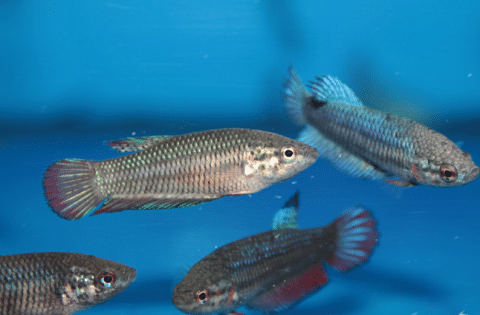
Female bettas are generally less aggressive than males, and their shorter fins are less prone to damage. Paired angelfish can be more aggressive than single specimens, so a combination of one or more female bettas and a single angelfish might work the best, especially when combined with some of the other tips mentioned here.
Monitor Regularly
You should check in on aquarium fish every day, but risky combinations like betta fish and angelfish should be observed frequently, especially in the weeks after they are introduced. A community tank with betta fish and angelfish should be positioned somewhere you can monitor it throughout the day.
Watch out for any signs of aggression so that you can take action before serious injury can happen. Aggression often takes place during feeding times, so be especially alert when your fish are eating.
Feeding Your Fish
Adding food to different parts of the tank at the same time can reduce competition and conflict, but you should also be aware that bettas and angelfish have slightly different diets.
Betta fish are mostly carnivorous and will thrive on a diet of prepared dried food and live/frozen foods. Angelfish are more omnivorous so they need a prepared food suitable for their needs.
Best Betta Food
Fluval bug bites is made of various insect and shrimp ingredients making this a high quality source of protein
Live Plants
Live plants are beautiful to look at, fun to grow, and great for the health of your fish. They’re also perfect for breaking up the line of sight in the tank. This means fish are not always visible to each other, which reduces aggression. Large plants also provide hiding places where fish can escape if they feel threatened or are under attack.
Choose large plants like Amazon swords, vallisneria, and large Java ferns that will grow up into the water column, but don’t be afraid to add a few smaller species and floating plants to make your aquarium an even more natural environment.
One of the easiest background placement aquarium plants that can be kept. Provides excellent shelter for fish
You can also use artificial plants, but avoid firm plastic decorations that can cut and damage your betta fish fins. Live plants are always better for bettas!
Caves And Structure
The hardscape in your tank can also play an important role in breaking up line of sight and creating hiding spots. Rocks, driftwood, cave ornaments, and other decorations provide places where fish can set up territories or hide from dominant tank mates.
Choose fish-safe ornaments that are made for aquariums to avoid introducing any chemicals into your tank. You should also check for any sharp edges that can tear your fish’s fins.
Dither Fish
Sometimes, the best way to avoid aggressive behaviors is to add more fish. Dither fish are active species that create movement and make it difficult for an aggressive fish to single out a victim. The best options are active schooling fish that swim at various levels in the tank.
Busy bottom dwellers like cory catfish, or fast, active fish like rainbowfish make good dither fish, but it’s important to choose other fish that enjoy the same parameters as angelfish and bettas. Avoid nano dither fish that are small enough for angelfish to swallow. You can also try medium sized social fish like molly fish.
Plan B – What To Do When War Breaks Out
If it doesn’t work out between your angelfish and betta, you’re going to have an animal welfare issue on your hands, and the best thing to do is separate your fish or find a new home for one of them.
You may already have a spare tank that you use for quarantining or treating sick fish, but if not, it’s always a good idea to have an emergency option. You could even use a bucket or something similar as a (very) temporary solution, just make sure the container has not been used to hold any toxic chemicals.
Once your fish are separated, it’s time to come up with a long-term solution. Continue reading to learn about three possible options.
Try A Tank Separator
Installing a tank divider will allow you to keep these two species in one aquarium without any drama, but it does limit the swimming space for both fish and all the other species in the tank. Fish tank dividers are available for sale, or you can make your own to save some money for your next tank.
Budget Option
A DIYer's option. Divide your aquarium and house multiple Bettas!
With your fish separated in a single tank, you can start creating hiding spaces, adding more structure to break up their line of sight, and introducing live aquarium plants and dither fish.
If your fish still don’t get along after making some changes in the tank, you’re going to want to try one of these next options for a long-term solution.
Start A New Aquarium
Angelfish need much larger tanks than bettas, but you can create a great new home for a single betta fish in a tank as small as 5 gallons. This is usually the easiest and most cost-effective option, but it will limit your options for adding other species.
Male bettas are happy to live in their own tanks, but you’ll want to step up to a ten-gallon or larger if you plan on giving him some tank mates. Female betta fish can also be kept in their own tank, or you can keep a sorority of females in a larger aquarium.
There are great betta tank kits available, but you can also put your own tank together. Just don’t forget the heater and filter!
Starting a new tank is easier when you already have a cycled aquarium because you can seed your new filter with beneficial bacteria from the old tank to give the nitrogen cycle a jump start. However, you’ll still need to monitor your water parameters regularly, so keep that water test kit handy.
Check out my guide to fish-in cycling to make the transition as smooth as possible!
Rehoming
If your new angelfish isn’t getting along with your betta (or vice versa), and you don’t have the space for another aquarium, you might be able to return the fish to your local fish store. Call ahead and speak to someone at the store before taking your fish on another road trip.
Depending on their policy, you might not get a refund, but that’s still better than letting your fish get hurt. If the store has a no-return policy, you might want to ask any other fish keeping friends if they have space for a new fish or even put your pet up for sale to a good home.
Final Thoughts
So now you know why keeping angelfish and bettas together is a bad idea. Hopefully, you’ve also picked up some useful tips on how to keep the peace if you find yourself housing both species in the same tank.
While some fishkeepers have managed to keep these fish together successfully, I do not recommend trying it yourself. Rather check out my guides to angelfish tank mates and betta fish tank mates for some much safer options!
- About the Author
- Latest Posts
I’m thrilled that you found Aquarium Store Depot! Here you’ll find information on fish, aquariums, and all things aquatics related. I’m a hobbyist (being doing this since I was 11) and here to help other hobbyists thrive with their aquariums! I adhere to a high quality Editorial Process and Review products with real life field usage and practical analysis.


